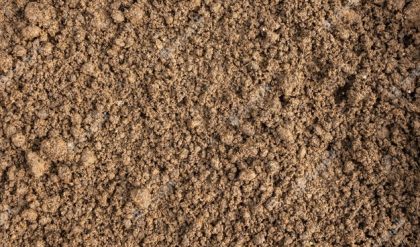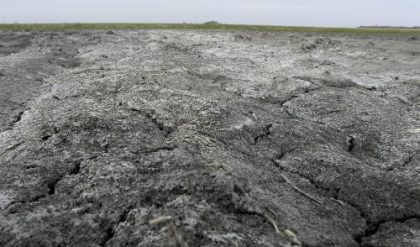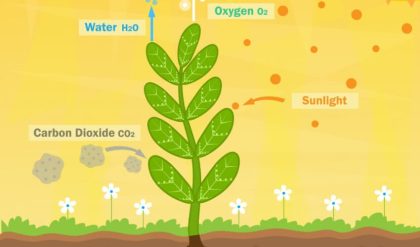Soil acts as a sponge to take up and retain water. Movement of water into soil is called infiltration, and the downward movement of water within the soil is called percolation, permeability or hydraulic conductivity. Pore space in soil is the conduit that allows water to infiltrate and percolate. It also serves as the storage compartment for water. Infiltration rates can be near zero for very clayey and compacted soils, or more than 10 inches per hour for sandy and well aggregated soils. Low infiltration rates lead to ponding on nearly level ground and runoff on sloping ground. Organic matter, especially crop residue and decaying roots, promotes aggregation so that larger soil pores develop, allowing water to infiltrate more readily. Permeability also varies with soil texture and structure. Permeability is generally rated from very rapid to very slow (Table 2.4). This is the mechanism by which water reaches the subsoil and rooting zone of plants. It also refers to the movement of water below the root zone. Water that percolates deep in the soil may reach a perched water table or groundwater aquifer. If the percolating water carries chemicals such as nitrates or pesticides, these water reservoirs may become contaminated.

Infiltration and permeability describe the manner by which water moves into and through soil. Water held in a soil is described by the term water content. Water content can be quantified on both a gravimetric (g water/g soil) and volumetric (ml water/ml soil) basis. The volumetric expression of water content is used most often. Since 1 gram of water is equal to 1 milliliter of water, we can easily determine the weight of water and immediately know its volume. The following discussion will consider water content on a volumetric basis.
Saturation is the soil water content when all pores are filled with water. The water content in the soil at saturation is equal to the percent porosity.
Field capacity is the soil water content after the soil has been saturated and allowed to drain freely for about 24 to 48 hours. Free drainage occurs because of the force of gravity pulling on the water. When water stops draining, we know that the remaining water is held in the soil with a force greater than that of gravity.
Permanent wilting point is the soil water content when plants have extracted all the water they can. At the permanent wilting point, a plant will wilt and not recover. Unavailable water is the soil water content that is strongly attached to soil particles and aggregates, and cannot be extracted by plants. This water is held as films coating soil particles. These terms illustrate soil from its wettest condition to its driest condition.
Several terms are used to describe the water held between these different water contents.
Gravitational water refers to the amount of water held by the soil between saturation and field capacity.
Water holding capacity refers to the amount of water held between field capacity and wilting point.
Plant available water is that portion of the water holding capacity that can be absorbed by a plant. As a general rule, plant available water is considered to be 50 percent of the water holding capacity. The volumetric water content measured is the total amount of water held in a given soil volume at a given time. It includes all water that may be present including gravitational, available and unavailable water.
The relationship between these different physical states of water in soil can be easily illustrated using a sponge. A sponge is just like the soil because it has solid and pore space. Obtain a sponge about 6 x 3 x 1/2 inch in size. Place it under water in a dishpan, and allow it to soak up as much water as possible. At this point, the sponge is at saturation. Now, carefully support the sponge with both hands and lift it out of the water. When the sponge stops draining, it is at field capacity, and the water that has freely drained out is gravitational water. Now, squeeze the sponge until no more water comes out. The sponge is now at permanent wilting point, and the water that was squeezed out of the sponge is the water holding capacity. About half of this water can be considered as plant available water. You may notice that you can still feel water in the sponge. This is the unavailable water.
Water in the form of precipitation or irrigation infiltrates the soil surface. All pores at the soil surface are filled with water before water can begin to move downward. During infiltration, water moves downward from the saturated zone to the unsaturated zone. The interface between these two zones is called the wetting front. When precipitation or irrigation cease, gravitational water will continue to percolate until field capacity is reached. Water first percolates through the large pores between soil particles and aggregates and then into the smaller pores.
Available water is held in soil pores by forces that depend on the size of the pore and the surface tension of water. The closer together soil particles or aggregates are, the smaller the pores and the stronger the force holding water in the soil. Because the water in large pores is held with little force, it drains most readily. Likewise, plants absorb soil water from the larger pores first because it takes less energy to pull water from large pores than from small pores.
Use of soil water estimates on a percentage volume basis does not allow for any practical interpretation. Therefore, water is usually converted from a percentage volume basis to a depth basis of inches of water/foot of soil (Table 2.5).

The table values are derived from laboratory analysis of soil samples. Some of this information is also published in the Soil Survey. Other techniques have been developed to estimate soil water if laboratory data is not available. Generally, field capacity is considered to be 50 percent of saturation and permanent wilting point is 50 percent of field capacity.
Water holding capacity designates the ability of a soil to hold water. It is useful information for irrigation scheduling, crop selection, groundwater contamination considerations, estimating runoff and determining when plants will become stressed. Water holding capacity varies by soil texture (Table 2.6).

Medium textured soils (fine sandy loam, silt loam and silty clay loam) have the highest water holding capacity, while coarse soils (sand, loamy sand and sandy loam) have the lowest water holding capacity. Medium textured soils with a blend of silt, clay and sand particles and good aggregation provide a large number of pores that hold water against gravity. Coarse soils are dominated by sand and have very little silt and clay. Because of this, there is little aggregation and few small pores that will hold water against gravity. Fine textured clayey soils have a lot of small pores that hold much water against gravity. Water is held very tightly in the small pores making it difficult for plants to adsorb it.
Since soil texture varies by depth, so does water holding capacity. A soil may have a clayey surface with a silty B horizon and a sandy C horizon. To determine water holding capacity for the soil profile, the depth of each horizon is multiplied by the available water for that soil texture, and then the values for the different horizons are added together. These determinations are shown for two soils in Table 2.7.

Water relations are greatly affected by cultural practices, but the effect is largely indirect. For instance, tillage breaks down aggregates, decreasing the number of large pores. This would cause a decrease in infiltration rate and percolation, the water content at field capacity would increase, and gravitational water would decrease. If compaction causes an increase in the number of very small pores, unavailable water may increase, and water holding capacity may decrease. As a result, the amount of plant available water would also decrease.






Comments are closed.